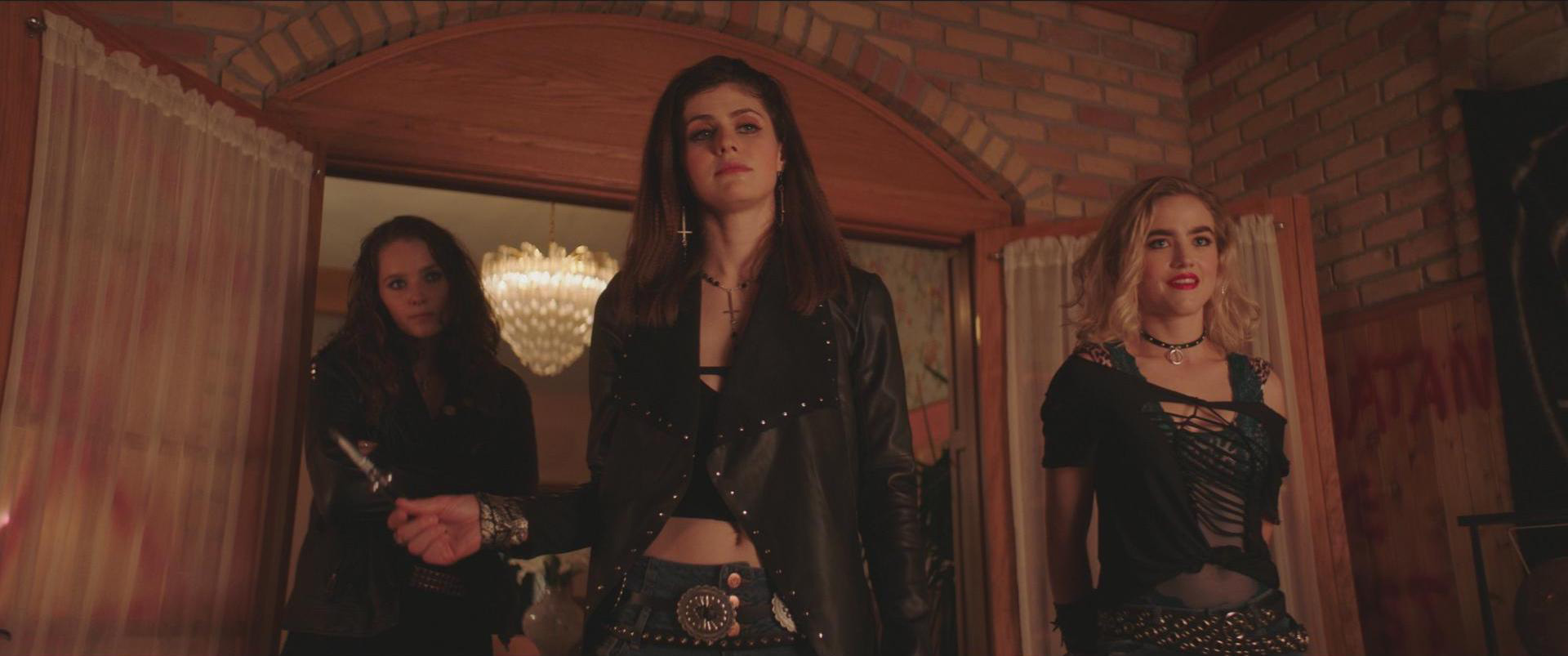A rash of 1980s-era satanic ritual killings puts Pastor John Henry Butler (Johnny Knoxville) front and center in rural America’s consciousness because his church is doing its very best to combat the disintegration of society with the word of God. Just as his increased television appearances rally the Bible Belt to his cause (treating rock music and other not quite “demonic” practices as sinful weapons destroying their children’s souls), however, they also work to embolden those he is forsaking. More than calling out the as yet unknown murderers for their crimes, he’s pointing fingers at a youth culture that already exists as a response to his mode of fear-mongering and idiotic censorship. So of course they’ll rebel further by running away to embrace their heavy metal lives more.
That’s the effect satanic panic had and what similar cases of adults turning their noses at the next generation’s artistic desires still possess. The old guard works itself into a frenzy while the new guard pulls away more—farther and farther until inevitably growing up to do the same with their own offspring. It won’t always lead to deaths, but sometimes that type of notoriety is what both sides believe is necessary to spark change and become a part of the global consciousness. Maybe the perpetrators are those who embody this alternative approach to life and therefore confirm what the detractors have been saying all along. Or maybe it’s the result of the righteous adhering to a utilitarian way of thinking that wields violence as a teachable lesson.
All we know for certain at the start of director Marc Meyers and screenwriter Alan Trezza’s We Summon the Darkness is that we’re destined to witness this so-called death cult in action. There’s no other reason to show Pastor Butler on the TV or play reports of the carnage on the radio if a first-hand account of what’s truly happening doesn’t arrive. The question is therefore whether or not those wielding the knives will be a trio of women (Alexandra Daddario’s Alexis, Maddie Hasson’s Val, and Amy Forsyth’s Bev) or men (Austin Swift’s Ivan, Keean Johnson’s Mark, and Logan Miller’s Kovacs). Both are driving along the highway en route to a concert with pentagrams and upside crosses adorning their vehicles, clothes, and jewelry. Both are looking for excitement.
The ladies are obviously the more confident group between the pair, but their talk about the genre of music simultaneously has too many holes and too much detail. The guys have been trailing the tour for multiple dates and prove the messier of the two crews by being prone to tipping their hands towards not so savory practices—plying their new friends with alcohol and drugs, owning switchblades, and already almost killing someone on the road via a not so harmless prank. So we wait for the six of them to have their fun at the show and continue the evening elsewhere. We wait for them to pair off and wonder who will pounce. Why is Kovacs coming on so strong? Why is Bev so nervous?
It’s not too hard to guess who the villains and who the victims are or the motivations concerning the why and how of the homicides themselves if you’re a horror fan. Satanic panic has its historical source and purposes and Trezza and Meyers use them to convolute things to True Blood levels of subterfuge, violence, and humor. And no sooner does the killing begin that domestic complications arise to ensure a wrench is always being thrown into the proceedings. Maybe someone gets angry too soon and stabs prematurely. Maybe someone gets cold feet to provide captives a chance to escape. Maybe a stepmother (Allison McAtee) crashes the party to “powder” her nose and accidentally brings even more heat than a mere doorbell ring. How will these kids react?
That is what they are after all. Kids. Mark is about to move to Los Angeles as a sort of post-school reset. Bev has never been to a concert before. Ivan likes to act cool and Alexis likes to be in control, but even they show their age via their inability to disguise impulsive enthusiasm. And between Kovacs’ indefatigable mouth and Val’s tiny bladder, there’s always something to mock or joke about as each and every one of them approach their endgame. For some it’s the prospect of sex. For others it’s the promise of blood. In the end, though, every action is rendered for the audience’s benefit as the need to survive and fulfill a duty respectfully opens room for an influx of unexpected insanity.
We Summon the Darkness reveals itself to be a fun ride when all is said and done because nobody on-screen knows what he/she is doing. The killers adhere to a faulty playbook built upon half-baked ideology and the prey ultimately works from a place of desperation wherein everything becomes fair game. Johnson and Forsyth end up being overly serious as their respective group’s outliers, but it works because they’re also the sane ones keeping “calm.” Their portrayals allow for Swift’s sense of over-confidence and Miller’s penchant for flirting with the line of obnoxiousness while letting Daddario and Hasson chew every last inch of scenery to steal scenes with their unwavering dedication to the premise’s outlandishly rowdy tone. What the plot lacks in surprises, this cast compensates via entertainment.
We Summon the Darkness hits VOD and Digital HD on April 10.

